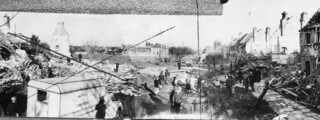A sharp crack and a heavy explosion
Liam Shaw
The first V2 to hit London fell on Staveley Road, Chiswick, on the evening of Friday, 8 September 1944. There was a small gathering to commemorate the 75th anniversary at the site last Sunday.
Unlike the V1s, which you could hear coming with the buzzing of their pulsejet engine – Iris Murdoch described watching them ‘tottering past the window’ – V2s gave no warning at all. Fired from continental Europe and tracing out a parabola into space, they fell at supersonic speed from at least fifty miles up. The Staveley Road explosion features in Gravity’s Rainbow: ‘The Moment was 6:43:16 British Double Summer Time.’ (I think Pynchon invented the spurious accuracy of the time.) Tyrone Slothrop is at Bond Street station when he hears,
suddenly in the sky, miles behind his back and up the river mementomori a sharp crack and a heavy explosion, rolling right behind, almost like a clap of thunder. But not quite … Not a buzzbomb, not that Luftwaffe. ‘Not thunder either,’ he puzzled, out loud.
A panoramic photograph (above) shows the devastation caused by the ‘mystery explosion’, which was clearly something new. The official explanation was an exploding gas main, but the arrival of ‘government bigwigs’ (as residents put it) within an hour of the blast suggested otherwise. The bigwigs included Herbert Morrison, the minister for home security, and the Labour MP Ellen Wilkinson.
The V2 landed in the middle of the road, making a crater eight feet deep, thirty feet wide and thirty-six feet long. Three people were killed. Sapper B.H.W. Browning, home on leave, was killed walking towards Chiswick Station. Rosemary Clarke, aged three, died in her cot, suffocated by the blast, with no sign of injury on her body; her brother, in another room, survived. Next door, Ada and William Harrison were sitting down to dinner when the V2 hit. She was directly hit by a falling steel joist and killed. He was badly injured but survived, dying in 1947.
The first V1 is commemorated with a blue plaque, put up by the GLC in 1985. The first V2 has no plaque. James Wisdom, the president of the Brentford and Chiswick Local History Society, told me they had tried and failed to get one for the 50th anniversary. According to the English Heritage guidelines, plaques will only be placed on ‘building fabric that is contemporary with or pre-dates the association being commemorated’, and ‘never on the site of a former residence’. For obvious reasons, this rules out Staveley Road.
The V2 was designed by Wernher von Braun. He and his colleagues were among the hundreds of Nazi scientists taken to the United States after the Second World War, in Operation Paperclip. Von Braun was the chief architect of the Saturn V rocket that carried the Apollo missions into space. In the 1980s, the Science Museum produced a poster commemorating the Staveley Road bombing as ‘the first step on the journey to the Moon’. Co-opting the V2 into the ceaseless march of progress obscures not only the thousands of victims of V2 attacks, but also the slave labourers who built the rockets: thousands of them died, too. As Tom Lehrer sang,
Some think our attitude
Should be one of gratitude.
Like the widows and cripples of old London town,
Who owe their large pensions to Wernher von Braun.
There is now a small memorial on Staveley Road. For the 60th anniversary, in 2004, the local history society worked with the Battlefields Trust to place a black granite stone at the site ‘in memory of all V2 attack victims’, just in front of a small electricity substation. They lay a wreath every year at the time of the impact.
Val Bott, a local historian, had warned me it would be a small gathering: ‘No speeches, no fuss and probably no crowd.’ There were eleven of us, including five of Ada and William Harrison’s grandchildren. Paul Harrison told me he’d only found out about the site after the 60th anniversary, after he mentioned to a colleague that he thought one of the earliest V2s to fall on London had killed his grandmother. We exchanged stories and looked at the surrounding houses and the patterns of damage, now visible as repairs.
The extent of the crater is also visible in the cherry trees planted at regular intervals along the road, which change from thicker, older prewar trees to more slender ones planted after the blast. One tree at the edge of the crater was repaired with concrete to fill in a great wound in its side. The tree has survived, its bark expanding around the lichen-covered concrete.

Comments